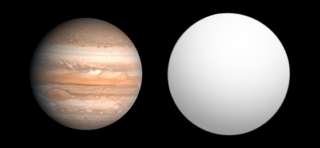Related Research Articles

CoRoT was a space telescope mission which operated from 2006 to 2013. The mission's two objectives were to search for extrasolar planets with short orbital periods, particularly those of large terrestrial size, and to perform asteroseismology by measuring solar-like oscillations in stars. The mission was led by the French Space Agency (CNES) in conjunction with the European Space Agency (ESA) and other international partners.

Eta Tucanae, Latinized from η Tucanae, is a probable binary star system in the southern constellation of Tucana, a few degrees to the north of Epsilon Tucanae. It is visible to the naked eye as a dim, white-hued point of light with an apparent visual magnitude of +5.00. parallax measurements provide a distance estimate of about 154 light years from the Sun, and it is drifting further away with a mean radial velocity of +32.5 km/s. It is a member of the 30 million year old Tucana-Horologium association of co-moving stars.
62 Andromedae, abbreviated 62 And, is a single star in the northern constellation Andromeda. 62 Andromedae is the Flamsteed designation; it also bears the Bayer designation of c Andromedae. It is bright enough to be seen by the naked eye, with an apparent magnitude of 5.31. Based upon parallax measurements made during the Gaia mission, it is at a distance of roughly 273 light-years from Earth. The star is moving closer to the Earth with a heliocentric radial velocity of −30 km/s, and is predicted to come to within 144.6 light-years in 1,6 million years.
CoRoT-4 is a yellow-white dwarf main-sequence star in the constellation Monoceros.

CoRoT-7b is an exoplanet orbiting the star CoRoT-7 in the constellation of Monoceros, 489 light-years from Earth. It was first detected photometrically by the French-led CoRoT mission and reported in February 2009. Until the announcement of Kepler-10b in January 2011, it was the smallest exoplanet to have its diameter measured, at 1.58 times that of the Earth and the first potential extrasolar terrestrial planet to be found. The exoplanet has a very short orbital period, revolving around its host star in about 20 hours.
CoRoT-2 is a yellow dwarf main sequence star a little cooler than the Sun. This star is located approximately 700 light-years away in the constellation of Aquila. The apparent magnitude of this star is 12, which means it is not visible to the naked eye but can be seen with a medium-sized amateur telescope on a clear dark night.
CoRoT-6 is a magnitude 13.9 star located in the Ophiuchus constellation.

Psi2 Piscium (ψ2 Piscium) is a white-hued star in the zodiac constellation of Pisces. It is faintly visible to the naked eye, having an apparent visual magnitude of +5.56. Based upon an annual parallax shift of 8.66 mas as seen from Earth, it is located about 380 light years from the Sun. It has a peculiar velocity of 14.6±2.9 km/s, indicating it is a runaway star.

QW Puppis is a class F3V star in the constellation Puppis. Its apparent magnitude is 4.49 and it is approximately 69.5 light years away based on parallax.

GJ 3470 b is an exoplanet orbiting the star GJ 3470, located in the constellation Cancer. With a mass of just under 14 Earth-masses and a radius approximately 4.3 times that of Earth's, it is likely something akin to Neptune despite the initially strong belief that the planet was not covered in clouds like the gas giants in the Solar System.
CoRoT-11b is a transiting Hot Jupiter-sized exoplanet found by the CoRoT space telescope in 2010.

CoRoT-14b is a transiting Hot Jupiter exoplanet found by the CoRoT space telescope in 2010.
CoRoT-18b is a transiting Hot Jupiter exoplanet found by the CoRoT space telescope in 2011.
CoRoT-23b is a transiting Hot Jupiter exoplanet found by the CoRoT space telescope in 2011.
CoRoT-16 is a solitary star located in the equatorial constellation Scutum. With an apparent magnitude of 16, it requires a powerful telescope to be seen, and is located 2,400 light years away based on parallax.
CoRoT-23 is a star located in the constellation Serpens at a distance of about 1956 light-years from us. At least one planet revolves around the star.
CoRoT-8 is a star in the constellation Aquila at a distance of about 1239 light-years from us. At least one planet revolves around the star.
References
- ↑ Guenther, E. W.; et al. (January 2012). "Transiting exoplanets from the CoRoT space mission. XXI. CoRoT-19b: a low density planet orbiting an old inactive F9V-star". Astronomy and Astrophysics. 537 A136. arXiv: 1112.1035 . Bibcode: 2012A&A...537A.136G . doi: 10.1051/0004-6361/201117706 .
- ↑ "Notes on CoRoT-19 b". Extrasolar Planets Encyclopaedia . Retrieved February 25, 2019.
- ↑ Kokori, A.; et al. (14 February 2023). "ExoClock Project. III. 450 New Exoplanet Ephemerides from Ground and Space Observations". The Astrophysical Journal Supplement Series. 265 (1) 4. arXiv: 2209.09673 . Bibcode: 2023ApJS..265....4K . doi: 10.3847/1538-4365/ac9da4 . Vizier catalog entry
- ↑ "CoRoT-19 Planets in the system" . Retrieved February 25, 2019.
- ↑ Guenther, E. W.; et al. (2011), "Transiting exoplanets from the CoRoT space mission", Astronomy & Astrophysics, 537: A136, arXiv: 1112.1035 , Bibcode:2012A&A...537A.136G, doi:10.1051/0004-6361/201117706, S2CID 42622538